|
|
|
Sort Order |
|
|
|
Items / Page
|
|
|
|
|
|
|
| Srl | Item |
| 1 |
ID:
092547
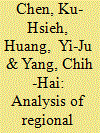

|
|
|
|
|
| Publication |
2009.
|
| Summary/Abstract |
This paper analyzes the dynamics of China's productivity for the period 1996-2004 with a newly developed methodology - generalized metafrontier Malmquist productivity index (gMMPI). Implementing the gMMPI, this paper reviews the inequality of the coastal and non-coastal provinces, as well as the latent impact of scale efficiency change (SEC) for China. Using provincial data for the years 1996-2004, the empirical results are as follows. On average, China demonstrates an annual 3.191% productivity change, which is lower than 4.729% for the conventional MPI and accounts for about 26.508% of output growth over the period 1996-2004. Most of this change is propelled by technical progress, while a fraction is driven by the adjustment in production scale, and the efficiency change has an adverse effect. Furthermore, regional inequality is also found in this empirical work, and the productivity change of the coastal region is actually stronger than that of the non-coastal region. This paper also casts some focus on the China Western Development policy. Indeed, we do not find any outstanding achievement from the policy in the sample period, except that the west region sustained its rate of productivity change after 2000. Moreover, the SEC is found to be trivial in the advanced coastal region, but plays an important role in the relatively laggard non-coastal region. The implication of the positive SEC in the non-coastal region means that China's Western Development policy will improve the scale efficiency and the TFP growth of the west region.
|
|
|
|
|
|
|
|
|
|
|
|
|
|
|
|
| 2 |
ID:
092636
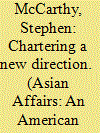

|
|
|
| 3 |
ID:
092526
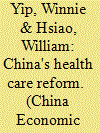

|
|
|
|
|
| Publication |
2009.
|
| Summary/Abstract |
China has recently unveiled an ambitious new health-care reform plan, entailing a doubling of government health spending as well as a number of concrete reforms. While the details of the plan have not yet been completely announced, we offer a preliminary assessment of how well the reform is likely to achieve its stated goal of assuring every citizen equal access to affordable basic health care. The reform is based on three fundamental tenets: strong role of government in health, commitment to equity, and willingness to experiment with regulated market approaches. Within this framework, the reform offers a number of laudable changes to the health system, including an increase in public health financing, an expansion of primary health facilities and an increase in subsidies to achieve universal insurance coverage. However, it fails to address the root causes of the wastes and inefficiencies plaguing China's health care system, such as a fragmented delivery system and provider incentives to over-provide expensive tests and services. We conclude that China should consider changing the provider payment method from fee-for-service to a prospective payment method such as DRG or capitation with pay-for-performance, and to develop purchasing agencies that represent the interests of the population so as to enhance competition.
|
|
|
|
|
|
|
|
|
|
|
|
|
|
|
|
| 4 |
ID:
092527


|
|
|
|
|
| Publication |
2009.
|
| Summary/Abstract |
Based on the idea that healthcare needs to be managed by individuals and that basic health services should be provided by the community, this paper examines the factors that impact urban outpatients' preferences for particular community health service centers (CHSCs) and hospitals. Rational consumption of healthcare is influenced by a patient's beliefs, beyond simple demographics and social structure. Ignorance of basic health issues leads to non-rational patient behavior, which also explains the confusion in Chinese health reform regarding people's mistrust of CHSCs. Health education in the form of self-managed care may increase personal health knowledge and encourage individuals to make use of the basic health services that are supplied by CHSCs.
|
|
|
|
|
|
|
|
|
|
|
|
|
|
|
|
| 5 |
ID:
092525
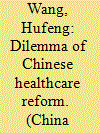

|
|
|
|
|
| Publication |
2009.
|
| Summary/Abstract |
This paper discusses the government's roles in the healthcare sector in China. The paper begins with an introduction to the Chinese healthcare sector (supply and demand side) and to the current government's roles. It then reviews the recent transformation of the healthcare sector, with an emphasis on the change in the government's roles and the problems resulting from this transformation. The following is an examination of the latest healthcare reform policies and an exploration of pending government roles. Contrary to the opinion that problems existing in Chinese healthcare are primarily caused by market failure, this paper argues that the historically ambiguous and inappropriate roles of government in the provision of health care should be reexamined. This paper concludes that the most important issue facing the Chinese healthcare sector is finding the optimal balance between market and government.
|
|
|
|
|
|
|
|
|
|
|
|
|
|
|
|
| 6 |
ID:
092535


|
|
|
|
|
| Publication |
2009.
|
| Summary/Abstract |
Using a large panel dataset covering all manufacturing firms (above a minimum scale) in China from 1998 to 2005, this paper examines whether there exist productivity spillovers from foreign direct investment (FDI) to domestic firms. In estimating productivity, we control for a possible simultaneity bias by using semi-parametric estimation techniques. We find that Hong Kong, Macao and Taiwan (HMT) invested firms generate negative horizontal spillovers, while Non-HMT foreign invested firms (mostly from OECD countries) tend to bring positive horizontal spillovers in China. These two opposing horizontal effects seem to cancel out at the aggregate level. We also find strong and robust vertical spillover effects on both state-owned firms and non-state firms. However, vertical spillover effects from export-oriented FDI are weaker than those from domestic-market-oriented FDI.
|
|
|
|
|
|
|
|
|
|
|
|
|
|
|
|
| 7 |
ID:
092533


|
|
|
|
|
| Publication |
2009.
|
| Summary/Abstract |
We study the determinants of capital structure for 650 Chinese publicly listed companies over the period from 1999 to 2004. We posit that a firm's decision on capital structure is inherently dynamic, and estimate the resulting dynamic capital structure model. The main findings of the paper are as follows: (i) Chinese firms adjust toward an equilibrium level of debt ratio in a given year at a very slow rate; (ii) firm size, tangibility and state shareholdings are positively associated with firm's leverage ratio, while profitability, non-debt tax shields, growth and volatility are negatively related to firm's leverage ratio; (iii) lagged profitability has a negligibly small and positive impact on firm's leverage ratio; (iv) for a firm experiencing a large reduction in its leverage ratio only about 11% of the discrepancy between its desired and actual leverage level is eliminated within a year (compared to more than 18% for full firm sample); (v) extending the basic model to allow for both the target level and the speed of adjustment to be endogenously determined, we find that Chinese firms tend to adjust faster if they are farther away from the equilibrium leverage level; and lastly (vi) extending the sample period to cover the earlier periods starting from 1993, when the Chinese stock markets were first developed, results in a slower speed of adjustment for firms in the below target sample.
|
|
|
|
|
|
|
|
|
|
|
|
|
|
|
|
| 8 |
ID:
092543
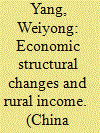

|
|
|
|
|
| Publication |
2009.
|
| Summary/Abstract |
During the reform period, the Chinese rural economy has experienced deep structural changes: cropping adjustment, agro-forestry adjustment and agro-industrial adjustment. At the same time, rural per capita income rose sharply despite some fluctuations. Using a panel data of 29 provinces from 1982 to 2001, effects of these structural changes upon both income level and income instability are assessed. The empirical results show that crop adjustment and agro-industrial adjustment can increase rural income and reduce income instability, while agro-forestry adjustment reduces both income and its instability, as a risk-management strategy.
|
|
|
|
|
|
|
|
|
|
|
|
|
|
|
|
| 9 |
ID:
092549


|
|
|
|
|
| Publication |
2009.
|
| Summary/Abstract |
The increase in oil prices in recent years has occurred concurrently with a rapid expansion of Chinese exports in the world markets, despite China being an oil importing country. In this paper we develop a theoretical model that explains the positive correlation between Chinese exports and the oil price. The model shows that Chinese growth can lead to an increase in oil prices that has a stronger impact on its export competitors. This is due to the large labor force surplus of China. We then examine this hypothesis by estimating a reduced form equation for Chinese exports using Rodrik [Rodrik, Dani, 2006. What's so special about China's exports? China and World Economy 14, 1-19.]'s measure of export competitiveness, together with the oil price, productivity, real exchange rate, and foreign industrial production over the monthly 1992-2005 period. The results suggest a stable relationship and yields slightly positive values for the price of oil and elastic coefficients for export competitiveness, along with the expected negative elasticity for the real exchange rate.
|
|
|
|
|
|
|
|
|
|
|
|
|
|
|
|
| 10 |
ID:
092540
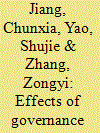

|
|
|
|
|
| Publication |
2009.
|
| Summary/Abstract |
China has accelerated banking reform since joining the Word Trade Organisation (WTO) in 2001. Employing a stochastic distance function approach, this paper examines bank technical efficiency and differentiates the static, selection and dynamic governance effects on bank efficiency for the 11-year period 1995-2005. The results show that bank efficiency has improved. Joint-stock ownership is associated with better performance in terms of profitability than state ownership (static effect). Strong selection effects are found for both foreign acquisition and going public reform strategies. Foreign acquisition may benefit domestic banks by efficiency gains in the long run, but privatization via initial public offerings (IPOs) appears to have only some short-term effects.
|
|
|
|
|
|
|
|
|
|
|
|
|
|
|
|
| 11 |
ID:
092524


|
|
|
|
|
| Publication |
2009.
|
| Summary/Abstract |
The purpose of the present paper is to show that much of the literature on health economics and on the international experience with different forms of health system organization can be interpreted as supporting the idea that reliance on an unregulated market mechanism for organizing the production and financing of health services is likely to result in major problems both with respect to efficiency and equity. However, reliance on a centralized "command-and-control" model managed by government has also been shown to entail problems in practice. For this reason I argue that the best option at China's current state of development may be a compromise model in which competing private providers are given an important role, both for the production of health services and in the provision of health insurance, but in which the government intervenes (through regulation and direct provision) in such a way as to attain both a high degree of equity of access to health care, and to avoid the most significant forms of "market failure" that would arise in an unregulated private system.
|
|
|
|
|
|
|
|
|
|
|
|
|
|
|
|
| 12 |
ID:
092536


|
|
|
|
|
| Publication |
2009.
|
| Summary/Abstract |
This paper examines the underpricing of IPOs in the Chinese A-share market during the period 1992-2006. Since its inception, the Chinese IPO market has transformed from a tightly-controlled system to a more market-oriented system. Reforms include the abolishment of listing quotas and fixed issue price determination; allowing for more market participation in IPO pricing. The regulatory changes of Chinese IPO market, though improving over time, actually are not monotonic. The regulatory framework started from over-restrictive to over-unrestrictive, then fine-tuned with additional restrictions. This study documents the regulatory reforms during the sample period and investigates how these regulatory changes affect IPO underpricing in China. During this period, we find that Chinese IPOs exhibit a huge underpricing. The size of the underpricing, however, decreases over the sample period. This study further finds that the IPO pricing method before the regulatory changes, which was based on a fixed P/E ratio pre-determined by the regulators, contributed significantly to the IPO underpricing in China. After adopting a series of regulatory reforms allowing underwriters discretion in the determination of issue price, this regulatory underpricing component vanishes. This study has policy implications in demonstrating the impacts of regulatory frameworks on IPO underpricing.
|
|
|
|
|
|
|
|
|
|
|
|
|
|
|
|
| 13 |
ID:
092541


|
|
|
|
|
| Publication |
2009.
|
| Summary/Abstract |
This paper tries to answer the long-standing question of whether money causes output. Instead of focusing on domestic monetary policy and output, we analyze U.S. monetary policy and its possible effects on real output in China. Our results indicate that the main monetary instrument in the U.S., the Federal Fund Rate, Granger causes China's output. A second monetary variable, U.S. money supply, does not seem to have a significant effect on China's output. The results are supported by variance decompositions, which indicate that Federal Fund Rate shocks have an effect on China's real output. The findings have important implications for policy makers in China that focus on maintaining a high and stable economic growth.
|
|
|
|
|
|
|
|
|
|
|
|
|
|
|
|
| 14 |
ID:
092545


|
|
|
|
|
| Publication |
2009.
|
| Summary/Abstract |
In this paper we undertake a comparative study of productivity in the manufacturing sector for China and India using data from survey of manufacturing industries for the two countries. We find that productivity of manufacturing industries in China relative to that in India improved substantially over the 1998-2003 period. Specifically, the average total factor productivity (TFP) growth for the manufacturing sector over this period was about 11% higher in China than in India. We document two substantial changes in government policies in China that were not witnessed in India. First, the late 1990s saw an enormous wave of ownership restructuring due to the formal endorsement of private property rights by the Chinese central government. Second, in 1997 a large scale labour retrenchment program was launched to address the long standing problem of labour redundancy in the public sector. Using data from the Chinese survey of manufacturing industries, we quantify the impact of these large scale institutional changes on TFP of Chinese manufacturing industries. We find that these policy changes can explain about 30% of the growth in TFP of manufacturing industries. Hence we conclude that these institutional changes in China can account for a significant part of the gains in productivity of manufacturing industries in China relative to that in India over the 1998-2003 period.
|
|
|
|
|
|
|
|
|
|
|
|
|
|
|
|
| 15 |
ID:
092528


|
|
|
|
|
| Publication |
2009.
|
| Summary/Abstract |
The health care delivery system in China, which is dominated by state hospitals, is being increasingly challenged by public concerns: it is too expensive and too inaccessible, a complaint commonly phrased as "kai bin nan, kan bin gui" in Chinese. As the penetration of for-profit hospitals has gradually increased, there is a growing need for policy research to assess their impact on medical spending from the patient perspective. Using panel data at the provincial level in China, this paper examines the impact of the penetration of for-profit hospitals on average medical expenditures for both outpatient and inpatient services in public general hospitals. Based on fixed-effect model estimates, the study shows that the penetration of for-profit hospitals has lowered the average medical expenditures for both inpatient and outpatient services across regions, especially for pharmaceuticals. Together with other results, this study finds no evidence that private for-profit hospitals drive up average medical expenditures while serving their profit-maximization objectives. Rather, they help increase the market supply of health care, which in turn better serves the increasing demand.
|
|
|
|
|
|
|
|
|
|
|
|
|
|
|
|
| 16 |
ID:
092538
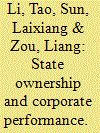

|
|
|
|
|
| Publication |
2009.
|
| Summary/Abstract |
This study assesses the impact of government shareholding on corporate performance using a sample of 643 non-financial companies listed on the Chinese stock exchanges. In view of the controversial empirical findings in the literature and the limitations of the least squares regressions, we adopt the method of quantile regression and report a robust and significant negative relation between government shareholding and corporate performance among, and only among, the more profitable firms. This new finding, which the conditional mean-focused regressions do not capture, suggests that while Chinese government still exerts influences on the performance of these partially privatized firms, the relationship parameter changes across quantiles of the distribution of performance variables.
|
|
|
|
|
|
|
|
|
|
|
|
|
|
|
|
| 17 |
ID:
092530


|
|
|
|
|
| Publication |
2009.
|
| Summary/Abstract |
A national household survey for 2002, containing a specially designed module on subjective well-being, is used to estimate pioneering happiness functions in rural China. The variables that are predicted by economic theory to be important for happiness prove to be relatively unimportant. Our analysis suggests that we need to draw on psychology and sociology if we are to understand. Rural China is not a hotbed of dissatisfaction with life, possibly because most people are found to confine their reference groups to the village. Relative income within the village and relative income over time, both in the past and expected in the future, are shown to be important for current happiness, whereas current income is less so. Even amidst the poverty of rural China, attitudes, social comparisons and aspirations influence subjective well-being. The implications of the findings for the future and for policy are considered.
|
|
|
|
|
|
|
|
|
|
|
|
|
|
|
|
| 18 |
ID:
092546


|
|
|
|
|
| Publication |
2009.
|
| Summary/Abstract |
The purpose of this paper is to analyze the technological system of Chinese manufacturing. The input-output method and network analysis are applied to investigate the structure and performance at the system level and the role of each sector at the individual level in 1997 and 2002. Firstly, the R&D-flow matrices for per unit output are constructed to examine the technology intensity and constitution of each sector. And then they are combined with the economic size and R&D investment structure in order to have a more comprehensive understanding of the system at the gross level, and reveal the main technology diffusion providers, acquirers and techno-economic flows between sectors. Results of both years show that the R&D performance and technology providing for diffusion are more concentrated than technology acquiring, and this difference becomes even greater in 2002. There are fewer sectors which act as main technology diffusion sources while more sectors participate as acquirers of technology diffusion. The techno-economic flows have high dependence on a few traditional sectors and the contribution of high-tech sectors such as ICT is quite limited.
|
|
|
|
|
|
|
|
|
|
|
|
|
|
|
|
| 19 |
ID:
092531


|
|
|
|
|
| Publication |
2009.
|
| Summary/Abstract |
This paper investigates the sources of economic fluctuations in China since its reform that started in 1978. Using the framework of a standard neoclassical open economy model with time-varying frictions (wedge), we study the relative contribution of the efficiency, labor, investment and foreign debt wedges to the business cycles of China. The business accounting procedure suggests that productivity best explains the behavior of aggregate economic variables in China throughout the period of 1978-2006. The labor wedge plays a major role in explaining the movement of labor force. The foreign debt wedge and investment wedge primarily affect the composition of output, but their role in explaining the movement of output is modest. Our results suggest that the focus of government policies should be to combat the problems of inefficient factor utilization and labor market rigidity.
|
|
|
|
|
|
|
|
|
|
|
|
|
|
|
|
|
|
|
|
|